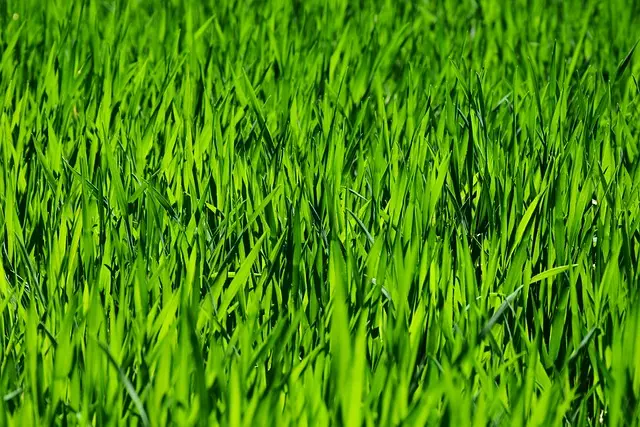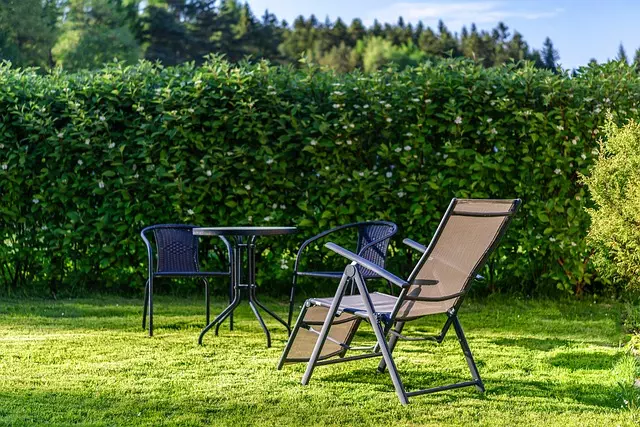Lawn care and landscaping are integral practices for creating an attractive and sustainable outdoor space. A well-maintained lawn requires precise mowing heights to promote grass density and root strength, complemented by strategic watering to foster drought-resistant turf, especially in regions with water scarcity. Fertilization should be tailored to the specific needs of different grass types and the seasons for optimal nutrient uptake. By incorporating sustainable practices such as organic fertilizers, native plants, and composting, these efforts not only enhance the visual appeal but also contribute to environmental preservation and cost savings. Advanced technology like smart irrigation systems and electric lawn equipment can further conserve resources while reducing environmental impact. A diverse plant selection, strategic hardscape placement including pathways, patios, and retaining walls, and the integration of outdoor lighting extend the usability of these spaces into the evening, creating a multifaceted, aesthetically pleasing environment that aligns with personal lifestyle preferences and enhances curb appeal. This holistic approach to lawn care, landscaping, and hardscape design ensures a sustainable, comfortable, and visually appealing outdoor sanctuary that reflects individual style while functioning as an extension of the home.
Embark on a journey to transform your outdoor space into a serene retreat with our comprehensive guide on lawn care, landscaping, and hardscape design. We’ll explore the basics of maintaining a lush, healthy lawn as the cornerstone of your outdoor oasis. From there, learn how to integrate sustainable practices into your lawn maintenance routine, ensuring both environmental harmony and aesthetic appeal. Next, discover how to make thoughtful landscaping choices that not only complement your environment but also enhance the overall ambiance of your yard. Finally, we’ll delve into the creation of durable and attractive hardscape elements that will serve as the perfect accent to your well-tended greenery, providing a functional and beautiful space for years to come. Join us as we navigate through the essentials of outdoor space design and build.
- Understanding the Basics of Lawn Care for a Healthy Foundation
- Integrating Sustainable Practices into Your Lawn Maintenance Routine
- Enhancing Your Outdoor Space with Thoughtful Landscaping Choices
- Building Durable and Aesthetic Hardscape Elements to Complement Your Yard
Understanding the Basics of Lawn Care for a Healthy Foundation

Engaging in meticulous lawn care is foundational to achieving a lush, vibrant outdoor space that complements any landscaping design. The health of your lawn serves as a canvas for the broader landscaping elements, and its maintenance can significantly influence the overall aesthetic and functionality of your outdoor area. A consistent routine of mowing, watering, and fertilizing not only promotes a verdant expanse but also contributes to soil health and pest management. Mowing at the correct height aids in maintaining grass density, deters weeds, and encourages root growth, which is essential for turf resilience. Additionally, proper watering practices, such as deep, infrequent irrigation, help establish deep-rooted, drought-resistant grass varieties, which are increasingly important in regions experiencing water scarcity. Fertilization should be tailored to the type of grass you have and the seasonal conditions, ensuring that nutrients are available when the lawn needs them most. This thoughtful approach to lawn care lays a solid foundation for any landscaping project, allowing for a harmonious blend of greenery, hardscapes, and outdoor living features that elevate your outdoor space. By understanding and implementing these fundamental lawn care practices, you set the stage for a beautiful and sustainable landscape that can be enjoyed for years to come.
Integrating Sustainable Practices into Your Lawn Maintenance Routine

Incorporating sustainable practices into lawn care and landscaping is not only beneficial for the environment but also contributes to long-term savings and a healthier yard. To begin with, opting for eco-friendly lawn maintenance methods reduces the ecological footprint of gardening activities. For instance, employing organic fertilizers instead of chemical alternatives not only nourishes the soil and promotes plant health but also prevents nutrient runoff that can harm local waterways. Additionally, choosing native plants for landscaping purposes supports biodiversity by providing habitats for local wildlife while requiring less irrigation due to their adaptation to the regional climate. Implementing a routine of organic lawn care, such as composting grass clippings and leaves to enrich the soil, is another practice that minimizes waste and promotes a robust soil ecosystem. Furthermore, proper mowing techniques, like keeping the blades sharp and set to a higher cut, encourage healthy root growth and reduce the need for frequent mowing. By adopting these sustainable lawn care practices, homeowners can create beautiful, resilient outdoor spaces that contribute positively to their local environment.
Advancements in landscaping technology also play a pivotal role in sustainable lawn maintenance. Smart irrigation systems that use moisture sensors can significantly reduce water usage by applying only the necessary amount of water. Similarly, electric or battery-operated lawn equipment is not only quieter but also free from emissions, making them a cleaner and safer option for maintaining your lawn. The strategic placement of trees, shrubs, and perennials can provide natural shade and windbreaks, further reducing the need for artificial interventions to manage lawn conditions. By integrating these sustainable landscaping practices into your routine, you not only enhance the beauty and health of your lawn but also contribute to a more sustainable future for our planet.
Enhancing Your Outdoor Space with Thoughtful Landscaping Choices

Embellishing your outdoor space through intentional landscaping can significantly elevate both the aesthetic appeal and functional aspects of your property. By integrating lawn care and landscaping practices, you can create an environment that is not only visually pleasing but also sustainable and comfortable for relaxation or entertainment. Thoughtful landscaping begins with a comprehensive plan that considers the unique characteristics of your outdoor area, such as soil type, sunlight exposure, and local climate conditions. Tailored lawn care strategies will maintain a lush, green turf that serves as the perfect canvas for garden elements. The integration of diverse plant species, including shrubs, perennials, and seasonal flowers, can introduce vibrant colors and textures while promoting biodiversity. Strategic placement of hardscapes like pathways, seating areas, or water features can enhance movement within the space and provide focal points that draw the eye and add depth. Additionally, incorporating outdoor lighting can extend the enjoyment of your landscaped area into the evening hours, creating a serene ambiance. By prioritizing both the form and function in your outdoor design, you can achieve a harmonious balance that complements your lifestyle while enhancing the overall curb appeal of your home.
Building Durable and Aesthetic Hardscape Elements to Complement Your Yard

When embarking on the journey of outdoor space design and construction, incorporating durable and aesthetic hardscape elements can significantly enhance both the functionality and beauty of your yard. These structures, which include pathways, patios, retaining walls, and water features, serve as a canvas for your lawn care and landscaping efforts. Selecting materials such as concrete, natural stone, or brick not only withstand the elements but also add an element of sophistication to your outdoor living space. The choice of material often reflects personal style preferences while offering practical benefits like weather resistance and low maintenance. For instance, a well-designed paver patio can provide a durable surface for outdoor dining and entertainment, complemented by lush, well-maintained grass areas that invite relaxation and play. Similarly, strategically placed boulders or retaining walls can define different zones within the yard, serving both an architectural purpose and creating visual interest. The integration of lighting in these hardscape elements not only extends their utility into the evening but also enhances their visual appeal under the soft glow of outdoor illumination. By thoughtfully combining form and function, homeowners can create an outdoor sanctuary that is both a testament to their personal tastes and a functional extension of their living space, all within the realm of lawn care and landscaping.
Effective lawn care and strategic landscaping are cornerstones of a vibrant outdoor space, as detailed in this comprehensive guide. By laying a healthy foundation with proper lawn maintenance and integrating sustainable practices, homeowners can cultivate an environment that is both beautiful and eco-friendly. Enhancing one’s yard through thoughtful landscaping choices not only elevates its aesthetic appeal but also supports local ecosystems. Additionally, the addition of durable hardscape elements serves to complement these natural areas, creating a harmonious blend of functionality and beauty. In conclusion, a well-designed and built outdoor space is a testament to the artistry and care that goes into lawn care and landscaping, providing a tranquil retreat and a sustainable habitat that enriches one’s daily life.


